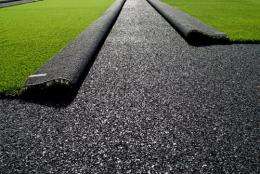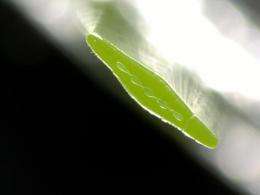Novel bi-component fiber developed

Empa researchers, together with TISCA TIARA, a Swiss manufacturer of artificial turf, have developed a novel fiber for artificial turf. The bi-component fiber returns to an upright position again and again thanks to a hard core and avoids abrasions and grass burns after a fall because of a soft sheath. The turf has already been laid on two football pitches in Switzerland.
Artificial turf is robust, durable and stands up to any weather. It allows to practice and to play all the year round and therefore became essential for today’s football.
A research team of Empa’s Advanced Fibers Laboratory, together with TISCA TIARA, a manufacturer of textile-based floor coverings, has developed a bi-component fiber. It contains two different polymers. The polyamide core has excellent recovery properties and therefore the fiber returns to an upright position again and again. The low-friction sheath of polyethylene avoids injuries after a fall. The turf has already been laid on two football pitches, one in Ecublens near Lausanne and the other in Bürglen in the Canton of Thurgau – and to the complete satisfaction of the footballers. It fulfils the essential requirements and comes visually very close to the natural grass which it is intended to imitate.
Either a flat pitch or abrasions
Artificial turf has been used since the 1960s. However, all the previous generations exhibited defects: The first generation of artificial turf was manufactured using polyamide fibres with excellent recovery properties and which always stood upright. But it’s exactly these resistant fibres which frequently led to grass burns and abrasions whenever someone took a tumble.

That’s why second-generation fibers consisted of polyethylene whose properties were much gentler to the skin. In practical use, however, these fibers also exhibited a serious defect: their resilience, or ability to stand upright after repeatedly being trampled upon, was very poor. Over time, the load on the fibers led to a downright flat pitch. That was not only visually unattractive, the “bent over” blades of artificial grass also changed how well the turf could be played on. As a result, an attempt was made to support the blades with sand or granulated material. Today, turf with a granulated infill is very common. However, it needs a lot of maintenance.
Different requirements for the artificial turf
“The requirements on artificial turf are quite varied,” notes Andreas Tischhauser, head of marketing at TISCA TIARA. “For instance, footballers want an especially soft grass surface while pitch operators want one with a long service lifetime. And, of course, it must also meet ecological requirements.”
The novel fiber should meet different needs. It should exhibit high resilience as well as optimal sliding friction behavior. Two properties implies the need for two components, thought Rudolf Hufenus, fiber expert at Empa in St. Gallen. According to this idea, such a fibre should contain a hard polyamide core surrounded by a low-friction sheath of polyethylene. Various cross-sections of the fibre have been modelled. The initial idea that the fiber should contain only one thick core failed. This fiber did not pass the Lisport test, which checks for long-term mechanical wear. With trial and error the project team finally created an optimal cross-section Instead of one core, the fiber consists of five thin ones. "We’re the first ones who have followed such a project through from the development of the fibre to the laying of the artificial turf“, boasts Hufenus proudly. The fiber’s resiliency qualities are guaranteed for years, as the Lisport test was able to prove.
The novel artificial turf meets all of TISCA TIARA’s needs: "We fulfilled the essential requirements of our industry partner for a new fiber used in artificial turf", adds Hufenus.
Provided by EMPA
















